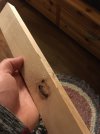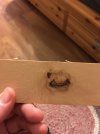I’m trying to true up a piece of birch for practicing hand cut joinery and just wanted to plane the edge grain for the heck of it to make it feel smooth. In doing so I noticed the grain goes from uphill to downhill on the same face due to a knot on the board’s face.
I’ve tried a Stanley #4 smoother as well as my Veritas low angle jack but I cannot get the edge flat across the entire length. I tried a shooting board and just in the vise.
Is there even a way to do this other than getting it close then finish with a card scraper ?
I’ve tried a Stanley #4 smoother as well as my Veritas low angle jack but I cannot get the edge flat across the entire length. I tried a shooting board and just in the vise.
Is there even a way to do this other than getting it close then finish with a card scraper ?




